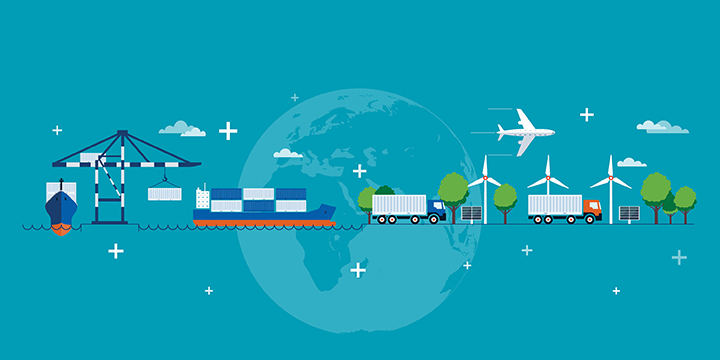Transforming the energy sector: What role will treasury play?
The energy sector is undergoing profound change. Our panel of specialists discuss industry developments, the implications for treasury and why digitisation is critical for success.

Barbara Harrison,
EMEA Sector Head for Energy & Power, Treasury and Trade Solutions (TTS), Citi

Christine McWilliams,
Global Head Commodity and Energy Trade, TTS, Citi

Peter Langshaw,
Head of Energy, Power & Chemicals Sector and Public Sector Sales for Latin America, TTS, Citi
“There can be significant overlaps between sustainability and digital.”
“We will be there to support treasury and its business partners as the industry transitions.”
“The energy transition is happening at a pace and scale unlike anything seen in recent decades.”
Please click on the questions below to read the text.
Christine: For companies in all sectors, the pandemic has meant that treasury teams have had to cope with remote working and an unpredictable business environment. However, in energy these challenges have been exacerbated by the deep structural shifts that are underway. The most important of these is the energy transition, which is resulting in a reduced focus on fossil fuels and an increased emphasis on renewables. This switch, along with crude prices generally trending lower since 2014, is prompting consolidation and strategic re-evaluation, resulting in reorganisations and staff reductions. Treasury complements the business and is therefore having to adjust to this new environment: digitisation is critical to that adjustment.
Barbara: In the short term, COVID-19 has elevated the importance of digitisation given the need for remote working. In the longer term, three megatrends are underway in the energy sector.
The energy transition is clearly number one: all of the energy majors that we work with are seeking to reduce their carbon footprint over the next 25 years. The second megatrend – digitisation – is common to other industries. Energy firms want to do more with less, not least because of the expected falling demand for oil and lower prices as the energy transition unfolds over the coming decades. And the third megatrend – efficiency – is closely linked to both the digitisation imperative and the energy transition. It’s essential for survival.
Peter: The COVID-19 pandemic and the oil downturn generated an unprecedented crisis in the industry. The crisis has had a profound impact on the sector and has been a catalyst for accelerating the need to make bold permanent shifts both in the short and long term, including changing strategies and business models across the various segments of the industry ecosystem. The industry outlook is likely to be characterised by a period of upstream and midstream consolidation, energy transition and rebalancing of the portfolio. For example, on the downstream/retail side of the business, the focus on end customers is becoming more relevant in the medium term to release value. On this note, we have been co-creating with a number of international energy clients to help them gain market share by adopting new digital innovations along the value chain to respond to new mobility trends and customer experience expectations.
Christine: Companies want to optimise their operations and evolve their strategy. Energy firms are also seeking to invest in and deploy new technologies such as blockchain, artificial intelligence and the Internet of Things as they think about their business model.
Underlying this is a need for companies to identify the biggest bang for their buck. Historically, digitisation has been seen primarily as a way to improve efficiency. Efficiency is still an important driver, and now digital is also seen as a way to help treasury leverage its own data, make better decisions and be a more effective partner to the business.
Barbara: Apart from giving clients better access to their own data, we are helping them to manipulate that data using innovative tools. For instance, many treasuries are looking at robotic process automation in relation to cash application in credit control and their shared service centres, or visibility of bank balances using APIs. We have solutions to enable these transformations. By consistently investing – and working with fintech partners – we can offer solutions to improve cash flow forecasting or enhance risk mitigation by analysing clients’ payment data to identify outliers, for instance.
Peter: Treasury is more than ever acting as an important partner to the business, leveraging digitisation and the next generation treasury technologies and tools across the businesses. As an example, using big data from our existing payment and business flows, we have been able to quickly identify areas for unlocking value, and cost and performance competitiveness for a large national oil company in Latin America by mapping and analysing the end-to-end payment, liquidity and working capital flows. Digitisation helps treasury to be agile in supporting the business’s needs and transformation by creating value – whether that is sales growth optimisation, supporting new business models, risk mitigation or customer experience design.
Another important role of digitisation in treasury is to help redesign end-to-end workflow processes to build operational resilience and at the same time increase efficiencies. Citi has been partnering with energy clients to open accounts digitally, and self-service daily business needs in a secure, remote operating environment.
Christine: Our global network is important for our energy clients. The energy business remains a physical business. Companies must consider where the resources are, whether that is fossil fuels or renewables, and we have a presence in the countries where the energy players operate so we understand those local markets. Energy companies need to make investments in renewables drawing on capital budgets, and their cash is generated in many jurisdictions around the world requiring increased sophistication in forecasting. That makes accurate cash flow planning using data, and liquidity management tools such as notional pooling, more important than ever. Similarly, in trade there is increased interest in easy-to-use digital solutions that bring liquidity forward and offer superior reporting without a heavy administrative burden. They enable treasury to partner with the business to achieve strategic goals.
Barbara: There are new models emerging such as energy-as-a-service (EaaS) where customers pay for an energy unit via a service contract and without making an upfront capital investment. Most often, EaaS takes the form of a subscription. Interest in the model is partly as a result of the growth of alternative energy sources. As petrol stations become providers of other fuels, including electricity and hydrogen, energy companies are increasingly viewing the business in a new way – not least because as the sector evolves there could be new entrants from the tech industry that take a fresh approach. Any change in how the business operates affects cash flow and therefore treasury must be closely involved from the start.
Christine: As companies explore new business models such as EaaS, digital becomes ever more important. Tracking the delivery of the service, renewal dates, usage patterns, and potential additional services becomes paramount. By looking at energy in terms of units, the potential risks and rewards of various types of energy also become more transparent, which will help guide future investment. Digital helps to enable energy companies to improve the user experience associated with EaaS by designing attractive monthly energy contracts, for instance.
Peter: Our new Digital Policy, Strategy and Advisory Practice allows us to formulate and share Citi’s perspective on technology and digital developments, such as crypto currencies, cyber security, AI, data and environmental, social and governance (ESG) issues. The Practice is not just about thought leadership. We are creating an advisory framework that will help all economic participants – including energy companies – to use digitisation to create value, achieve sustainable growth and productivity, and mitigate the risk of disruption. It will make it easier for energy clients to identify the implications of new business models and will deliver actionable insights to help transform their businesses in order to stay relevant in an increasingly digital world.
We are also developing a global series of training programmes for our clients on NextGen treasury technologies. In Latin America, for example, we are working with the University of Miami to provide training to 350 senior finance executives on the practical application of these technologies.
Barbara: The diagnostic framework is a client-centric tool that helps to define digital goals for treasury, their current position (benchmarked in relation to their peers), and the steps that they need to take to advance on their digital journey. It’s not about products – it’s a consultative process that helps clients on their digital journey.
Peter: The diagnostic framework essentially assesses the digital maturity of an organisation. But as well as defining the current state and target state, it enables clients to build a strong business case, develop financial models, define a change management strategy and the implementation trajectory. With all of the oil majors seeking to transform and digitise themselves over the next five years, there is strong demand for the type of support that we can offer through the framework.
Christine: As clients develop their ESG strategies, they will need digital tools to track their performance against the targets they set, and to design future ESG targets: we anticipate that clients will be constantly raising the bar for themselves, as they do in other areas of business performance. Digitization helps our clients work smarter, react more quickly to trends, and make better decisions. And of course, it helps to remove paper! It can also reinforce a strong governance strategy supporting know your client activities and inoculating trade flow documents, which can be vulnerable to tampering. For example, we have seen clients leverage blockchain-based trade financing platform Komgo to enhance their visibility and confidence in their trade flows with counterparties. Citi has made a strategic investment in Komgo as part of our broader data strategy given how critical data integrity is to international trade.
Peter: For the energy ecosystem there is an opportunity to infuse new vigour and digital technologies into environmental strategies and renewable energy businesses. As investments increase in environmental projects and renewable energy, new industries and opportunities such as lower carbon capture, utilisation and sequestration technologies (CCUS) and mobility options such as hydrogen are emerging; all of which demand digital solutions.
Barbara: We help clients to build out their treasury ESG strategy and then support them as they implement it. There can be significant overlaps between sustainability and digital. For example, we have an automated and digital sustainable supply chain finance programme that enables companies to offer sustainable suppliers – verified by an independent third party – the opportunity to boost their liquidity and accelerate cash flows by gaining access to finance at preferential rates. Corporates can then highlight this programme in their sustainability and annual reports.
We can also help companies with governance – the ‘G’ in ESG. For instance, we have a clear focus on device and transaction security, leveraging behavioural biometrics (such as monitoring typing patterns) and voice biometrics, and advanced tools to detect malware and data breaches. Citi Payment Outlier Detection uses data analytics tools to detect unusual transactions while Citi Payment Insights leverages big data, APIs and the cloud to give treasury visibility and control of payments. We also run digital education programmes, including webinars and one-to-one consultations, to help companies enhance their governance activities.
Peter: The energy transition is happening at a pace and scale unlike anything seen in recent decades. The headwinds it faces are significant: it may become harder for many companies to raise capital, even as they require more capital to fund investment in new areas such as renewables. Over time, through consolidation, the industry will become concentrated in larger, stronger companies better able to withstand cycles and embrace energy transition. In the meantime, companies are going to have to become more efficient, reduce their costs and funding needs and identify new sources of working capital such as supplier finance. Embracing digital will help them achieve this, by optimising cash flow within the company and enabling the business to make better-informed decisions.
Barbara: Emerging technologies such as robotics, AI and machine learning will help support agile supply chains and sustainable practices, accelerate efforts on digital retailing and help to build alternative business models. Treasury is at the heart of all of these developments: Citi will be there to help clients as they tackle their challenges and harness these opportunities.
Christine: Digitisation in the energy sector – leveraging technologies such as blockchain, the Internet of Things and AI – could be worth $220 billion over the next decade, according to the World Economic Forum. Digitisation and de-carbonation will go hand-in-hand given the need to make energy systems around the world more connected, efficient, reliable and sustainable. As the industry reshapes itself for the 21st century, treasury needs to be at the top table when decisions are made – we will be there to support treasury and its business partners as the industry transitions.
